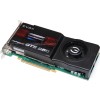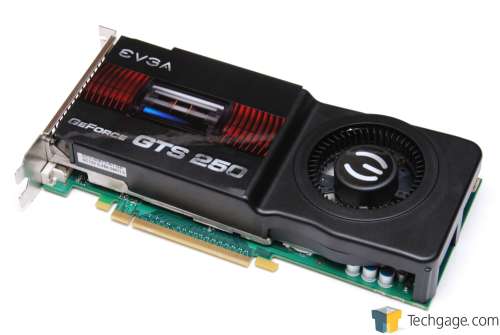- Qualcomm Launches Snapdragon 4 Gen 2 Mobile Platform
- AMD Launches Ryzen PRO 7000 Series Mobile & Desktop Platform
- Intel Launches Sleek Single-Slot Arc Pro A60 Workstation Graphics Card
- NVIDIA Announces Latest Ada Lovelace Additions: GeForce RTX 4060 Ti & RTX 4060
- Maxon Redshift With AMD Radeon GPU Rendering Support Now Available
EVGA GeForce GTS 250 Superclocked

The first mid-range offering of NVIDIA’s GeForce 200 series is here, in the form of the GTS 250. As a follow-up to the company’s 9800 GTX+, we already have a good idea of what to expect. But, various improvements aim to make things interesting, such as a redesigned PCB, smaller form-factor, single PCI-E connector, improved temperatures and refreshed pricing.
Page 10 – Final Thoughts
So, was NVIDIA’s GTS 250 worth the wait? That’s of course a comedic question, because as mentioned earlier, the company’s latest card is little different than the 9800 GTX+, which we’ve had available since last summer. That’s important to point out, because if you already own a decent GPU that you purchased within the past year, then the GTS 250 is not likely for you. It would be much more worthwhile to go with something a little beefier, such as the GTX 260/216.
But while the GTS 250 doesn’t bring anything entirely new to the table, it’s not really a waste of time, either. After all, we received a revamped PCB that allowed for a smaller form-factor, we cut down on one power connector, we enjoy lower temperatures and also more memory. Not to mention a revised price. It’s a solid addition to NVIDIA’s line-up, but it’s still too bad that we didn’t see a truly current-gen product, such as a scaled-down GTX 260/216.
As mentioned in our last few graphics card reviews, we’re still in the process of re-benchmarking our collection of current GPUs, so we’re missing a few notable ones here. I regret not being able to at least include the HD 4850 512MB for comparison’s sake, but time constraints got the better of me. I’m confident in the fact that the HD 4850 is quite comparable to the GTS 250, though, just as the original 9800 GTX+ was.
The fact is, the 9800 GTX+ is still a great card, and as seen throughout our test results, the only real gain seen from having 1GB worth of memory on board was with higher resolutions. But, that fact is rather moot, because if someone has the desire to game at 2560×1600, they’re not likely considering a $150 GPU. At least I’d hope not!
Before we wrap up, let’s discuss power and temps. First, the power. EVGA’s pre-overclocked GTS 250 idled at a comfortable 169W, and hit a max load of 324W. The 9800 GTX+, by comparison, idled at 195W and hit a max load of 313W. Odd results, as both cards had opposing benefits, but at least with the GTS 250, we’re down to one power connector.
Where temperatures were concerned, things improved even further with the GTS 250. While both cards hit a load temperature of 76°C, the GTS 250 idled 7°C cooler. That might not seem that impressive, but realize that the 9800 GTX+ was utilizing a robust third-party cooler (ASUS Dark Knight), so for the GTS 250 to hit the same load temperature with a reference design is great.
Aside from the card itself, NVIDIA of course touts many other features as well on the side, including their PhysX technology, their CUDA platform and also their 3D Vision gaming peripheral. Consider it a good or bad thing, NVIDIA has really been on the ball with cool technologies lately, and I personally find quite a bit of value in each one of these. PhysX will of course become more appreciated as time goes on, but CUDA has some cool uses now (such as video encoding), and will also (hopefully) improve a lot more over the course of this year.
You can expect us to take a continued look at each one of NVIDIA’s extra technologies as time passes. In particular I’d like to evaluate CUDA-based applications a bit more, since I haven’t spent much time with them in the past. I tried to gather some opinions of Badaboom for this article, but I quickly realized that much more time will be needed before I can make some solid conclusions.
That aside, although article embargos lift today, the cards are not going to be released until next week (March 10). At that time, the 512MB version of the card will be available for $129, while the 1GB model, as we took a look at here today, will retail for $149.
Discuss this article in our forums!
Have a comment you wish to make on this article? Recommendations? Criticism? Feel free to head over to our related thread and put your words to our virtual paper! There is no requirement to register in order to respond to these threads, but it sure doesn’t hurt!
Support our efforts! With ad revenue at an all-time low for written websites, we're relying more than ever on reader support to help us continue putting so much effort into this type of content. You can support us by becoming a Patron, or by using our Amazon shopping affiliate links listed through our articles. Thanks for your support!






